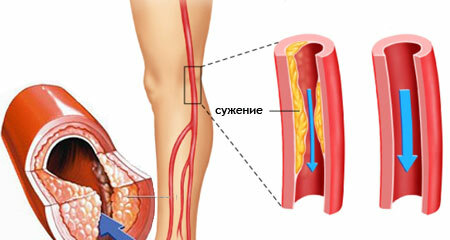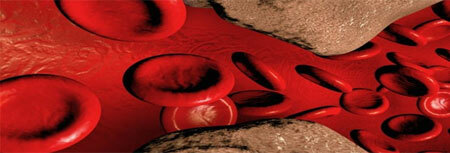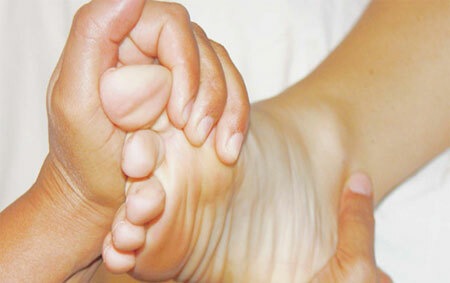We all know about atherosclerosis. This disease leads to unpleasant consequences: coronary heart disease, myocardial infarction. Atherosclerosis is also responsible for the development of ischemic stroke. It is this process that is indirectly responsible for the occurrence of cardiovascular diseases and their complications.
Thus, atherosclerosis is the culprit of the most common cause of human death in the 21st century. One of its manifestations, which is no less dangerous, is the destruction of the vessels of the legs. Today we will talk about this process, the phenomenon of obliteration of blood vessels, and we will dwell in detail on the diagnostic processes and methods of treating this serious disease.
Contents
- 1 Obliterating atherosclerosis - what is it?
- 1.1 Causes of the disease
- 1.2 Development of obliterating atherosclerosis
- 2 Symptoms of obliterating atherosclerosis of lower extremities vessels
- 3 Diagnosis of obliterating atherosclerosis
- 4 Treatment of obliterating atherosclerosis of lower extremities, drugs
- 5 Prevention
Obliterating atherosclerosis - what is it?

It is necessary to clearly realize that the obliterating atherosclerosis of the lower limbs is not a separate disease that affects the legs, but simply the place of the "greatest ferocity" of atherosclerosis in the body.
Atherosclerosis in general is a pathological process that narrows the lumen of the arterial blood vessels: large arteries, in the walls of which there are elastic and smooth muscle elements.
Following this, the target organs suffer: brain, heart, intestinal loops. In the case of atherosclerosis of the vessels of the lower limbs, the following are affected:
- Lower abdominal aorta, before branching( bifurcation);
- iliac arteries;
- Femoral arteries;
- Popliteal arteries and vessels of the shins, which are less likely to be affected, since their wall contains less muscle and elastic elements, and is therefore more difficult to obliterate.
As a result of the disease, there is a significant narrowing of the lumen of the vessel due to the deposition of cholesterol on its walls in the form of plaques. And if the infarct and stroke often occur due to clogging with a torn clot of a smaller vessel, obliteration of is a process of slow "overgrowing" of the vascular wall with the development of chronic oxygen starvation( ischemia) of the corresponding tissues, up to the development of necrosis and gangrene, which often occurswhen involved in the process of the vessels of the legs.
Causes of the disease
Like the process of other localization, obliterating atherosclerosis of the vessels of the lower extremities occurs mainly in the elderly, but recently the process began to grow young. If you meet 100 random people, then the symptoms of the disease you will find only three of them. If you interview 100 people, over 55, the number of cases will increase to 18-20 cases.
The course of the process often ends in a permanent disability: high amputation of the leg at the level of the thigh. At the same time, more than half of the patients who underwent this operation die in a year, as the process spreads ever higher.
Factors that reliably lead to atherosclerosis of the vessels of the lower extremities are:
- Male;
- Age. This is also an unmodifiable factor.
All other factors are amenable to correction, and can significantly reduce the risk:
- Long-term smoking experience;
- Hypertensive;
- High cholesterol, lipid metabolism disorder;
- Diabetes mellitus and other disorders of carbohydrate metabolism;
- Obesity and overweight;
- Hypodynamia. It is because of the dramatic growth of the inactive way of life in the cities that young people have an "obliterating" atherosclerosis in our century.
If you lead a healthy lifestyle, monitor your weight, blood sugar and cholesterol, the risk of the disease is significantly reduced.
Development of obliterating atherosclerosis
As with any other disease that obliterates atherosclerosis of the arteries of the lower extremities, it undergoes several stages in its development, which formed the basis for the most popular clinical classification.
The disease is divided into four stages. The first two - completely reversible with proper treatment:
- In the first stage, "failure of compensatory mechanisms" in the form of pain in the legs appear after a serious and prolonged load, for example, a pedestrian route of 20-30 kilometers;
- The second stage appears when it is impossible to walk more than one kilometer without pain, and then this distance is reduced to 250 meters, that is, actually, to the nearest store or kiosk( in urban conditions);
- In the third stage, a critical decrease in blood flow and pain occurs after 30-40 steps, and even at rest, especially at night. In order to ease pain and improve blood flow, the patient can lower his leg from the bed at night;
- In the fourth stage, small and then more extensive trophic ulcers appear first. The skin turns black, extensive fields of necrosis of the skin, cellulose and muscles are formed. There is a sharp restriction of mobility, and then the inability to walk independently. Then a secondary infection is attached, dry or moist gangrene of fingers and heels arises, in which only amputation can save. In case of neglected cases, sepsis, infectious - toxic shock and death occur in cases of multiple organ failure.
How does this dangerous disease manifest itself, and what should I look for?
Symptoms of obliterating atherosclerosis of lower extremity vessels

All symptoms of obliterating atherosclerosis of the lower limbs are different manifestations of the syndrome of acute and chronic ischemia of various organs and tissues: skin, muscles, fiber, bones, joints, vascular wall that arise both at rest and during movement.
Let's enumerate them:
- Pain in the leg muscles is the main sign of obliterating atherosclerosis - aching thighs and calves. Unfortunately, the muscles loaded with walking can not get more blood, and they respond with aching pain. A person has to limp, stop, wait for the cessation of pain and move on. This phenomenon is called claudicatio intermittens, or intermittent claudication. It is so called because the person limps impermanently, it "intersperses" with periods of normal walking. Then the pain becomes permanent;
- Reduced blood flow in the distal areas leads to a cooling and sensation of numbness in the feet, as well as a violation of nervous sensitivity. Sensations also increase with physical activity;
- Hot-cold leg - since less blood enters the sick leg, the healthy leg appears hotter than the affected one;
- Appearance of the lower leg and foot( where the blood vessels are smaller and the blood supply is less) non-healing ulcers, severe trophic disorders( fragility of the nails, hair loss);
- Occurrence of darkened skin areas, absence of pulsation on popliteal artery and ankle indicates irreversible blood flow disturbance.
Diagnosis of obliterating atherosclerosis
The pattern of abnormalities in obliterating atherosclerosis of the lower extremities is so obvious that clinical diagnosis is the main one.
It is only necessary to correctly and consistently identify the patient's complaints, their connection with physical activity, as well as conduct an examination, determine the temperature, arterial pulse, trophic extremities.
More subtle diagnostics are performed on the levels of damage. There is a high level( aorta and iliac arteries, with the development of Lerish syndrome, when there are pains in the buttocks and thighs, incontinence of gases and violation of potency), and a low level of damage when the shins and feet ache.
It is important to identify the period in which critical limb ischemia occurs. It is characterized by the appearance of constant pain, with an increase in the night, with relief when the foot is lowered from the bed. Raising back reinforces the pain. At this time, the systolic pressure in the affected vessels drops below 50 mm.
Confirmation of the diagnosis is made using:
- Treadmill test with increased load on the treadmill. So determine the painless distance;
- Carrying out ultrasound of the vessels of the legs. In this case, the LIP, or the ankle-brachial index, is calculated. This ratio of pressure in tibial pressure to pressure in the brachial artery, measured in systole. In the norm, the indicator is more than one, and when the disease it decreases;
- Pulse oximetry in the toes, both standing and lying;
- For accurate localization, color dopplerography of the vessels of the legs is performed. This determines the place of critical stenosis and its extent.
In this case, one should not forget about the verification of coronary and carotid arteries, since sometimes there is a much more serious problem that determines the sequence of treatment. For example, at first aortocoronary bypass surgery is required, and then surgery on the vessels of the legs.
Treatment of obliterating atherosclerosis of the lower extremities, preparations

When treating the obliterating atherosclerosis of the lower limbs, we must not forget that atherosclerosis is a systemic process, therefore, in addition to restoring local blood flow, it is necessary to prevent attempts of "relapse".
In the first, second, and partly the third stage, conservative treatment is possible, the operations provide for the restoration of arterial patency.
After achieving critical ischemia - it is possible palliative surgery with excision of necrosis and even amputations, as the only radical way to save the body.
Principles of conservative treatment are as follows:
- Non-drug treatment: modification of all risk factors: effective treatment of hypertension, weight loss, smoking cessation, correction of diabetes mellitus. It is necessary to achieve lowering the level of systemic cholesterol when it is increased, both by diet and by drugs;
- The appointment of vasoactive drugs that reduce the aggregation of erythrocytes in the vascular bed. These include pentoxifylline, trental. Reopoliglyukin and Reomacrodex also have a good antiaggregation effect( with infusion application);
- Use of agents that reduce platelet aggregation. These are all known "heart" aspirins in a dosage of 100 to 325 mg per day. Clopidogrel is the most effective drug, it is also Plavix.
- A good drug is Sulodexide, which belongs to heparin derivatives, and is able to reduce the viscosity of plasma, reducing the concentration of fibrinogen and certain lipids;
- Phlogenzyme and Wobenzym - proteolytic enzymes. They are used to reduce the inflammatory component, reduce the severity of trophic ulcers;
- Xanthinal nicotinate is used as a means of dilating blood vessels.
In addition, laser irradiation of blood, the use of ultraviolet lasers can be used in therapy. They stimulate the breakdown of fibrin, and reduce the viscosity of the blood.
In addition to therapeutic methods of treatment, use and operational methods. In general, x-ray endovascular stenting is very popular, and balloon dilatation of the affected arteries, especially if there is evidence: an isolated site of single stenosis on a narrow vessel space.
Somewhat less often, such interventions are used as:
- Sympathectomy, which, as a symptomatic operation, protects from arterial spasm, dilates small vessels and restores blood flow;
- Osteotomy with revascularization. After special damage to the bone, new small vessels appear in the limb, which redistribute the blood flow.
Prevention
Serious disease obliterating atherosclerosis of the lower limbs, the treatment of which we described, is completely reversible in the initial stages. But almost no one goes to the doctor if his legs get hurt after ten or twenty kilometers, but in vain.
The annual passage of ultrasound of the vessels of the lower extremities will allow timely action not only against this disease, but also against varicose veins, which often complicates the course of atherosclerotic lesions of the arteries.
A healthy lifestyle, proper nutrition, motor mode, no bad habits and an ideal weight is the key to your freedom from vascular damage, and will allow you to stay active for many years.



